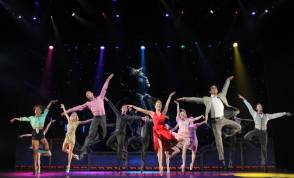
The dance moves of premier choreographer Twyla Tharp and the vocals of Ol’ Blue Eyes himself combine to captivating perfection in Tharp’s Come Fly Away, brought to vivid life by a troupe of extraordinary young dancers and an onstage big band to rival the best of Nelson Riddle, Billy May, or Neil Hefti.
The Tony-nominated musical revue has just touched down at Orange County’s Segerstrom Center For The Arts in a production certain to delight Sinatra and dance fans in equal measure. In fact, a key to the show’s artistic and popular success is that each camp can enjoy it every bit as much as the other, and if you happen to love both dance and Frankie, then you’re in for a double treat.
Choreographer/director Tharp sets Come Fly Away in a swanky nightclub, whose denizens (the show’s eight stars and six ensemble dancers) spend the night kicking up their heels to over two dozen Sinatra smashes—all the way through to the wee hours of the morning and “One For My Baby” (“and one more for the road”) … followed by a one-two punch grand finale of “My Way” and “New York, New York.”
What sets Come Fly Away’s dance sequences apart from most Broadway ensemble numbers is that, unlike traditional production numbers, no matter how many dancers Tharp has on stage (as many as the entire cast of fourteen), individuals or couples are for the most part dancing their own thing, making each song-and-dance sequence a particular visual feast. Tharp’s choreography effortlessly blends ballet, jazz, ballroom, and swing moves, often at the same time on the same stage—a heady mix.
As for Sinatra’s songs, through the magic of technology, The Chairman Of The Board’s prerecorded vocals have been isolated from their original orchestrated tracks, allowing us to hear an amazingly live-sounding Frankie crooning or belting out his hits to a fourteen-piece band as live and lively as they come.
Each of the show’s star dancers gets a character name, several character-defining outfits, and a dance partner for the evening. There’s Babe (Meredith Miles), Betsy (Ramona Kelley), Chanos (Matthew Stockwell Dibble), Hank (Anthony Burrell), Kate (Ashley Blair Fitzgerald), Marty (Christopher Vo), Sid (Stephen Hanna), and Slim (Marielys Molina)—each of them more wow-worthy than the next.
Katherine Roth’s costumes give each of the principals his or her own distinctive look, allowing us to imagine a “storyline” for each, the production’s book (by Tharp) being expressed entirely in dance. For the record, we have volatile lovers Hank and Kate (think Frank and Ava); fickle Babe, who changes partners midway through, from Chanos to Sid, with Slim more than willing to take her place with # 1; and the waiter-waitress duo of Marty and Betsy, who fall in love over the course of the evening.
With so many sensational stars, it’s hard to play favorites, but leggy, long-tressed Fitzgerald is a knock-out in the role that scored her Broadway counterpart a Tony nomination, and Vo is a charismatic charmer as a waiter who’s such a (deliberately) bad dancer that he nearly sabotages his budding romance with moves more likely to injure than seduce.
Backing the show’s principal dancers are its equally talented ensemble, each of whom has his or her own eye-catching moments. The performance reviewed here featured swing Marceea Moreno, Nathan Madden, Candy Olsen, Julius Anthony Rubio, Tanairi Sade Vasquez, and Michael Williams.
Music director Rob Cookman conducts and plays piano in a band so sensational they deserve mention by name: Tom Colclough, Buddy Fambro, Mike Herriott, Jim Keen, Clifton Kellem, Mark J. Miller, James Nelson, Neil Nicholson, Sam Oates, P.J. Perry, Paul Ringenbach, Adam Schroeder, and Julian Tanaka. Cookman, trumpeter Herriott, trombonist Nelson, and reed player Perry each get their follow-spot solo moments, and accompanying cheers.
Design elements are as stunning as they get, from the aforementioned Roth’s costumes, to James Youmans’ glitzy scenic design to Donald Holder’s dazzling lighting to Peter McBoyle’s crystal-clear sound design.
Kim Craven is associate director/choreographer, Ron Todorowski resident director, and John M. Galo stage manager.
With only eight scheduled performances during its all-too-brief one-week run at the Segerstrom, Come Fly Away is Must-See-Immediately entertainment. There’s not a more exciting way to spend eighty minutes in the O.C. than with Twyla, Frank, and Come Fly Away.
Segerstrom Center For The Arts, 600 Town Center Drive, Costa Mesa.
www.scfta.org
–Steven Stanley
January 31, 2012
Photos: Joan Marcus






 Since 2007, Steven Stanley's StageSceneLA.com has spotlighted the best in Southern California theater via reviews, interviews, and its annual StageSceneLA Scenies.
Since 2007, Steven Stanley's StageSceneLA.com has spotlighted the best in Southern California theater via reviews, interviews, and its annual StageSceneLA Scenies.







 COPYRIGHT 2025 STEVEN STANLEY :: DESIGN BY
COPYRIGHT 2025 STEVEN STANLEY :: DESIGN BY